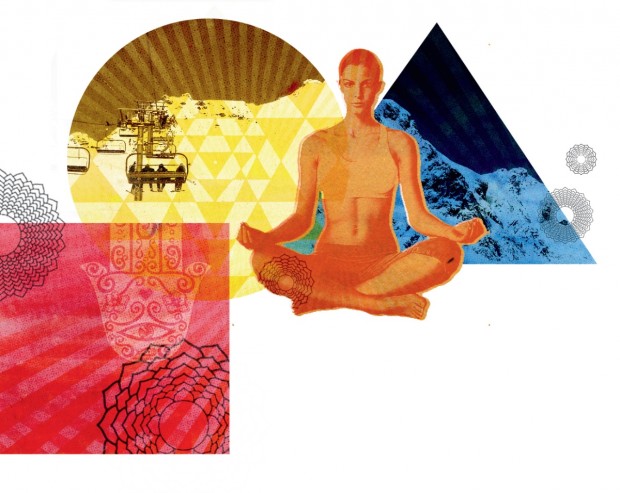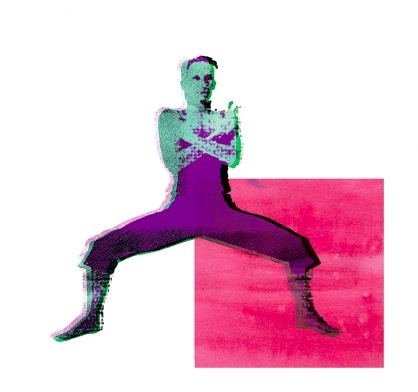
After a long, grey autumn, nothing warms the cockles more than white flakes dancing in front of your window again. But a full-on assault on your first snow day back can easily end in muchas pain, thankfully yoga can help you avoid that by training your flexibility and tweaking your concentration
Words by Anna Langer
Everybody is unique, with different strengths and weaknesses, quirks and persuasions, so alas there’s no magic formula to whip your body into winter shape. Instead you have to listen to your own distinctive needs to work out exactly what’s best for you. Yoga not only gives you the chance to do that, it’s also an extremely good way to prepare for winter season. With special exercises, the asanas, this ancient Indian tradition strengthens your body while it trains flexibility and concentration. The asanas build up and stretch the muscles at the same time, so you’ll not only have more power in your turns and be able to last longer on the hill, you’ll also get a larger range of motion in your body and on your board or skis. No wonder yoga is a vital part in the training of many pros, such as X games and Olympic medallist Gretchen Bleiler, who sees it as “a great way to get your energy flowing.”
Alongside the benefits for the body, yoga has damn positive effects on the mind too.
With challenging positions that aren’t always easy to get into or hold, you’re virtually forced to concentrate on what you’re doing. And deep and conscious breathing helps you to direct your attention inwards. Clearing your mind and keeping the breath deep and steady even under strain are very helpful traits not only when you want to try something new or learn tricks on your board, but also when you have to deal with being nervous or scared. Because breathing boosts the energy flow through your body and gives you the opportunity to channel it. Powerful movements and ones where you open the body can be supported by inhaling, while the exhale relaxes the body and helps to make it more compact and folded together.
To get the most out of your yoga practice you’ll need to tailor it to fit your needs.
This is the idea behind Quantum Yoga by Lara Baumann. Her method encourages everybody to compile their own yoga sequence according to their own needs and daily changing conditions, instead of following what a course, teacher or DVD dictates. “Yoga is there to support your lifestyle, not the other way around, and if you’re involved in snowboarding or skiing you want to be doing a practice that supports that particular activity.” In the Quantum method each yoga sequence contains ten groupings and from each group you chose exactly those asanas that suits you and your current condition best. If you already have some experience with yoga you can start creating straight away, otherwise it’s better to start with the three pre-set sequences that have different focuses, and chose which one is the right for your particular needs.
Yoga is there to support your lifestyle, not the other way around
Though whatever you do, always stay mindful with your body. This is one of the ultimate principals in all yoga styles. Listening carefully to what your body needs isn’t only vital for choosing the asanas and creating a sequence, but also for executing them. Even if you already have a routine with certain poses, you should never do more or go deeper than your momentary condition allows. Instead use as many props as you need to feel safe and comfortable. This is a topic that is still often misunderstood by many yoga students. Lara says, “Don’t feel bad for using a lot of props. Actually you’re doing something very good and healthy for your body and you can go into the poses much deeper than when you’re in strain, so you’ll profit from the asana a lot more.”
Strike a pose
So to prevent injuries and overexertion on your first days in the snow, prepare your body with these special leg-strengthening exercises:
 1. Horse-Riding Stance
1. Horse-Riding Stance
As the joints are particularly injury-prone in winter sports, it’s especially important to strengthen the knees. Squatting poses such as the Horse Riding Stance from the Quantum Heroes sequence train the muscles around the knee and in the thighs.
Stand with spread legs, feet pointed outwards, erect spine and slightly tilted back pelvis, then hunker down until there’s a right angle between your thigh and lower leg. From this basic position you have a lot of possibilities. One variation would be to shift your weight to the right side and straighten the left leg and arm, while you move the right arm with the palm facing up over your head. Come back to middle in one fluent motion and repeat on the other side. Go back and forth like this a couple of times. If you want a bit more, instead of stretching the left arm and holding the right one over you head, you could also squat deeper and let the left arm rest on your left shin, while you grab your right ankle with your right hand and let the elbow rest against the knee. Even though this is a dynamic movement you should execute it precisely and be very careful you don’t hunch your back or tilt you pelvis to a hollow back.
2. Hero Pose
Besides strengthening the knees, it’s also helpful to encourage their normally rather poor blood supply with poses such as the Hero or the Half Frog. Sit with bent knees between your heels (if this is too uncomfortable or you can’t reach the floor, sit on a folded blanket or thick book), place your under arms behind you and gradually lay back until your shoulders and upper back rest on the floor. Make sure your knees don’t drift apart while you stay for a couple of breaths. This is the Hero. Or you can do the Half Frog where you lie on your stomach, lifting your chest up and bending the right leg. Place your left arm in front of you to support your upper body, while gently pushing the right foot down towards the flow with your right hand. “Both asanas temporarily reduce or stop the blood flow in the joint. When you slowly come out of the pose after a couple of breaths, the blood comes rushing back and supplies the knee with loads of oxygen,” explains Lara.
Don’t neglect the top half of your body in your practice though, as a strong core can also help to prevent injuries and overexertion, while also making you more stable and compact on your board.
Don’t forget to warm up properly before you start on the Yoga too!
And for more info on Lara visit larayoga.com

 1. Horse-Riding Stance
1. Horse-Riding Stance




